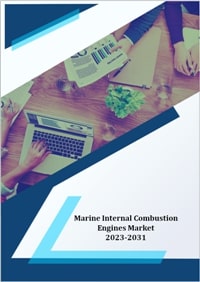
Marine Internal Combustion Engines Market Is Projected to Expand At A CAGR Of XX% Between 2023 And 2031. Combustion of fuel with air takes place within the engine in an internal combustion engine. Simple engine design, low operational costs, and high fuel economy as compared to external combustion engines is some of the factors responsible for its high usage in marine industry. These engines use the lowest grade of fuel like heavy oil and heavy diesel oil. These engines uses the lowest grade of fuel to ascertain economic viability, due to high volume consumption from ship’s engine as compared to other refined fuel like petrol, SKO (superior kerosene oil), etc.
Marine operations make up 60-70% of total costs incurred. Due to this high percentage, a lot of marine fleets are being exchanged for multiple uses like an anchor handling tug being temporarily used as offshore support vessels. This exchange has proven to be more economical for the marine asset operator. The larger ship sizes (bulk carriers, cargo vessels, tankers, etc.) utilize 2-stroke engines while the vessels with lower capacity vessels (Ro-Ro boats, Small Offshore Support Vessels, etc.) may utilize technologically advanced, compact, costlier turbocharged 4-stroke main propulsion and auxiliary engines.
The directives based on marine pollution to reduce the sulfur content to 0.5% by 2020, is one of the major reasons for inducing more advanced 4-stroke engines to reduce marine pollution and achieve operational profits. The marine sector is majorly involved in regional, cross-countries, and cross-continent trade activities, and hence the requirement of a fleet is essential to carry out these activities. There is a significant rise in disposable incomes of people where there is increased number of people opting for luxury leisure trips on cruises and own yacht’s. Mandates from IMO’s (International Maritime Organizations) MARPOL (Marine Pollution) convention and the Paris Agreement on pollution levels at sea are being strictly adhered to. There is increased awareness in utilizing advanced 4-stroke IC engines to achieve operational efficiency and emission standards. All these factors are propelling the demand for more marine internal combustion engines. Fluctuations in crude oil prices have led to decline in overall oil & gas exploration activities. This has a direct impact on the shipping industry as it is heavily dependent on oil & gas industry.
Based on engine type, the market is segmented into low-speed engine, medium-speed engine, and high-speed engines. In 2023, medium-speed engines dominated the internal combustion marine engine market, and a similar trend is expected during the forecast period. Based on applications, the market is segmented into bulk carriers, tankers, container vessels, cruise, passenger vessels, offshore support vessels and others (tugs, utility vessels, etc.).
Bulk carriers dominated the market in 2023. Geographically, Asia Pacific was the largest region for IC marine engines market. China, Japan and South Korea were the hot-spots for the market due to high trade, oil & gas, and ship building activities in the region. China is expected to grow at the highest rate since it has raised its marine diesel engine production rapidly on account of high merchant trade activities and increased oil imports from other regions.
Key players across the Marine Internal Combustion Engines value chain are:
Hudong Heavy Machinery, CSSC-MES Diesel, MAN Engines, Dalian Marine Diesel, Yichang Marine Diesel Engine, Qingdao Haixi Heavy-duty Machinery, Mitsubishi Heavy Industries Ltd., SCANIA, Yanmar Co., Ltd, and GE Ltd. amongst others.
Historical & Forecast Period
This study report represents analysis of each segment from 2022 to 2032 considering 2023 as the base year. Compounded Annual Growth Rate (CAGR) for each of the respective segments estimated for the forecast period of 2024 to 2032.
The current report comprises of quantitative market estimations for each micro market for every geographical region and qualitative market analysis such as micro and macro environment analysis, market trends, competitive intelligence, segment analysis, porters five force model, top winning strategies, top investment markets, emerging trends and technological analysis, case studies, strategic conclusions and recommendations and other key market insights.
Research Methodology
The complete research study was conducted in three phases, namely: secondary research, primary research, and expert panel review. key data point that enables the estimation of Marine Internal Combustion Engines market are as follows:
Market forecast was performed through proprietary software that analyzes various qualitative and quantitative factors. Growth rate and CAGR were estimated through intensive secondary and primary research. Data triangulation across various data points provides accuracy across various analyzed market segments in the report. Application of both top down and bottom-up approach for validation of market estimation assures logical, methodical and mathematical consistency of the quantitative data.
| ATTRIBUTE | DETAILS |
|---|---|
| Research Period | 2022-2032 |
| Base Year | 2023 |
| Forecast Period | 2024-2032 |
| Historical Year | 2022 |
| Unit | USD Million |
| Segmentation | |
Product
| |
Application
| |
|
Region Segment (2022-2032; US$ Million)
|
Key questions answered in this report